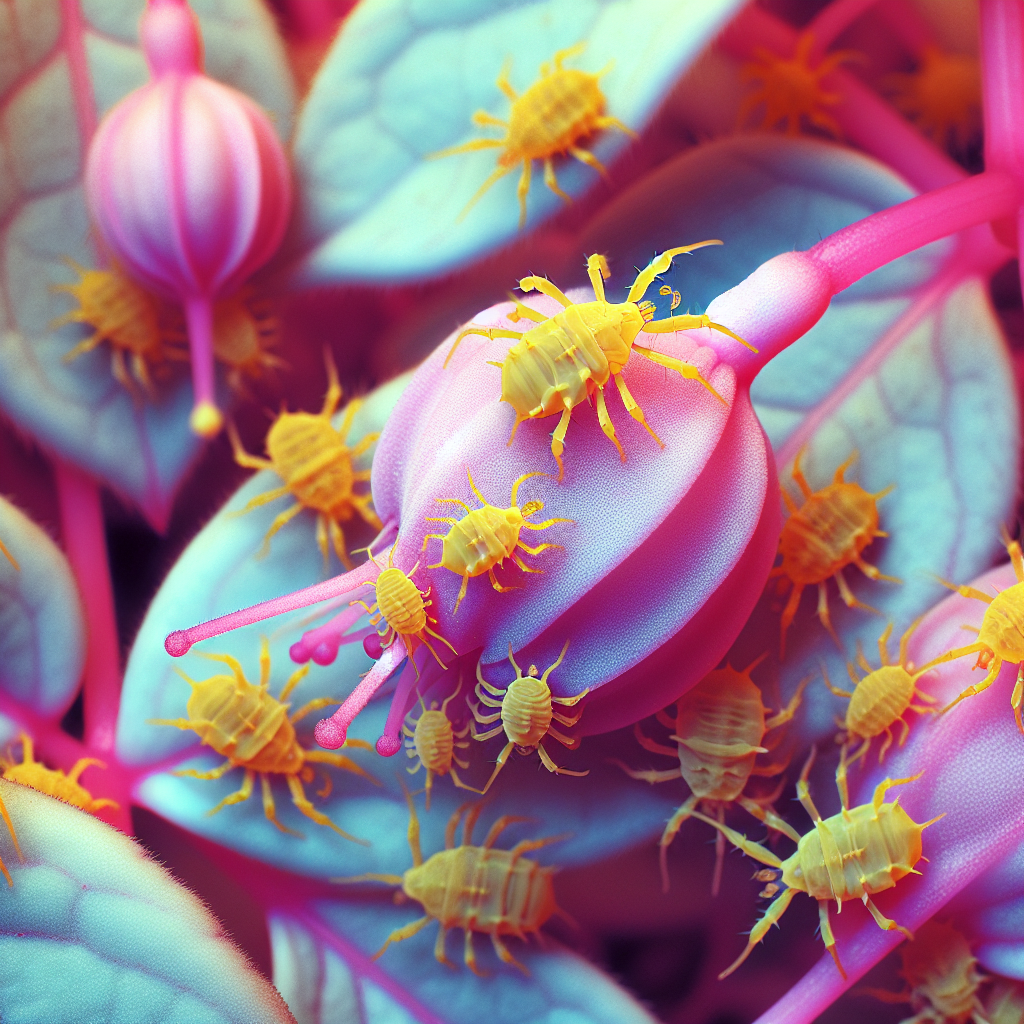The Fuchsia Gall Mite ( Aculops fuchsiae): A Detailed Examination of a Plant Pest
The Fuchsia Gall Mite (Aculops fuchsiae) is a microscopic arachnid, not an insect, that poses a significant threat to fuchsia plants and some related species. Its pest status stems from its ability to cause severe damage, affecting plant aesthetics, marketability, and potentially overall plant health.
Damage Caused:
The primary damage is the formation of galls – unsightly, distorted growths – on various plant parts. These galls can appear on leaves, stems, buds, and flowers. They typically begin as small, reddish or purplish swellings that progressively enlarge, deforming the plant tissue. Severely infested plants exhibit stunted growth, reduced flowering, and a generally unkempt appearance. Leaf galls can cause leaf distortion and drop, while flower galls can prevent proper flower development and opening resulting in fewer and smaller flowers. The overall aesthetic damage significantly reduces the commercial value of fuchsia plants, especially those grown for sale. While rarely fatal, severe infestations weaken the plant making it more susceptible to other stresses.
Life Cycle and Impact at Each Stage:
The Fuchsia Gall Mite has a short life cycle, with several overlapping generations throughout the growing season.
-
Eggs: Microscopic eggs are laid within the plant tissue, often in developing buds or leaf axils. The early impact is minimal, but the sheer number of eggs laid contributes to rapid population growth.
-
Larvae: Larvae are also microscopic and actively feed on plant tissues, stimulating gall formation. This stage is crucial as the feeding activity directly causes the characteristic galls.
-
Nymphs: Nymphs are similar in appearance to larvae but larger, continuing to feed and contribute to gall development and size.
- Adults: Adults are still very small (around 0.2 mm) and continue feeding, laying eggs, and perpetuating the infestation. The cumulative feeding activity of numerous adult mites leads to significant gall formation and plant deformity.
Plant Species Affected:
While primarily impacting Fuchsia species, the mite can also infest some related plants in the Onagraceae family, though the severity of the infestation may vary.
Variations in Impact:
The severity of infestation depends on several factors:
- Plant species/cultivar: Some fuchsia cultivars exhibit higher levels of resistance than others.
- Environmental conditions: Warm, humid conditions generally favor rapid mite reproduction and spread.
- Infestation level: The number of mites present directly correlates with the extent of damage.
Feeding Habits and Reproduction Rates:
The mites feed by piercing plant cells and sucking out their contents. This feeding stimulates the plant’s defense mechanisms, leading to gall formation. Their incredibly high reproductive rate, with several generations possible during a single growing season, makes them difficult to control.
Economic and Ecological Damage:
Quantifying the precise economic impact is difficult, but significant losses occur in the nursery and horticulture industries due to reduced plant marketability and increased management costs. The ecological impact is less well-defined but relates to the reduction in fuchsia plant populations and potential disruption of associated ecosystems.
Effective Insecticide Controls:
Chemical control can be effective but should be used judiciously due to potential resistance development and environmental concerns. Always follow label instructions carefully. Examples include:
- Spinosad: A naturally derived insecticide with relatively low toxicity to mammals. Some resistance has been reported.
- Abamectin: A relatively broad-spectrum acaricide (miticide) with good efficacy, but resistance is also a growing concern.
Safety Precautions and Resistance Concerns:
All insecticides should be used with caution, adhering strictly to label instructions regarding application rates, personal protective equipment (PPE), and environmental considerations. A crucial aspect is resistance management. Rotating different classes of insecticides and integrating them with other control methods are vital to mitigate the development of resistance.
Organic/Integrated Pest Management (IPM) Strategies:
- Biological control: Exploring the use of natural predators or mites remains an area of research.
- Cultural controls: Good hygiene practices, removing infested plant parts, and proper spacing to improve airflow can help reduce mite populations.
- Resistant cultivars: Selecting fuchsia cultivars with inherent resistance is a worthwhile long-term strategy.
- Water sprays: Regular, strong sprays of water can dislodge some mites.
Preventative Measures:
- Careful plant selection: Choose healthy plants from reputable sources, thoroughly inspecting them before purchase.
- Quarantine new plants: Isolate newly acquired plants for a period to observe for any signs of infestation.
- Hygiene: Remove fallen leaves and other plant debris regularly.
- Crop rotation (not applicable for perennials like fuchsia): Though not relevant for fuchsia, the principle is applicable to other plants susceptible to this mite.
Early Signs of Infestation and Monitoring:
Regular inspection is crucial. Look for the characteristic small galls on leaves, stems, buds, and flowers. Close examination may reveal the mites themselves, though specialized magnification may be required.
Natural Predators and Biological Control: Research into natural enemies of the Fuchsia Gall Mite is ongoing. There’s currently no widely used commercially available biological control agent for this specific pest.
Insecticide Resistance Management Strategies:
Rotation of insecticides with different modes of action, employing IPM strategies, and monitoring the effectiveness of treatments are crucial to prevent the development of insecticide resistance.
Recommendations for Suspected Infestation:
- Identify the pest: Confirm the presence of Fuchsia Gall Mite through careful observation and possibly microscopic examination.
- Implement IPM strategies: Begin with less harmful methods like removing infested plant parts, improving plant health, and using strong water sprays.
- Consider chemical control: Only resort to chemical control if necessary and follow label instructions carefully. Rotate insecticide classes to prevent resistance.
- Monitor and evaluate: Regularly check the plant for mite activity and re-assess control efforts as needed.
This information provides a comprehensive overview of the Fuchsia Gall Mite and strategies for its management. However, specific recommendations may vary depending on the local environment and specific conditions. Always prioritize integrated pest management approaches to minimize environmental impact and prevent insecticide resistance.
